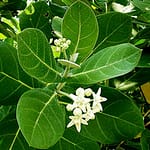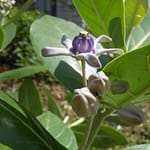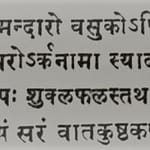
You may have heard of the white Aak plant whose leaves and flowers are considered auspicious to offer to Lord Shiva. Native to India, Malaysia, Thailand, Cambodia, Sri Lanka, China and a host of other Asian countries, the Madar plant is known by many names such as Calotropis Gigantea (Scientific name), Arka (Sanskrit name), Aak/Madar (Hindi name), and Sodom Apple (English name).
Numerous Ayurvedic products are made from the plant which includes Arkadi Ghrita, Arkadi Kashaya, and Asanadi Kashaya to name a few. It is interesting to note that plant is often used in many sun-worshipping ceremonies.
“Health is defined in Ayurveda as “soundness of body, organs and mind.” – Maya Tiwari
Medicinal Characteristics Of The White Madar Plant
- It is pungent and bitter in taste.
- It is light, dry, and sharp in terms of physical properties.
- It is hot in potency and has a pungent post-digestion effect.
- It is known to balance the Kapha and Vata doshas in the body.
Medicinal Properties Of This Plant Include:
- Anti-fungal
- Anti-diabetic
- Anti-carcinogenic
- Expectorant
- Aphrodisiac
- Anti-inflammatory
- Anti-coagulant
- Anti-dysenteric
- Anti-syphilitic
- Anti-rheumatic
Did You Know?
According to the ancient Shastras, placing the sacred Aak plant at the main entrance of your home can ward off negative energy and purify the environment.
Aak Plant’s Top Hotspots & Its Multi-Functional Uses

The Madar tree is commonly called – Aak ka ped – and offers a host of medicinal and spiritual benefits as it has a strong and astringent action. In fact, it is said that sitting near the plant and performing daily prayers can help realize all your dreams and wishes. That said, let’s look at the different parts of the plant and its primary health benefits in short:
- Aak leaf: Believe it or not, “Aak Ka Patta (leaf)” is the most commonly-searched Ayurvedic phrase. And rightly so. Aak leaves benefits are well-documented. Data claims that the aak leaf contains cardiac glycosides, an integral component in heart medication. This leaf is similar to the texture of the bamboo leaf, being thick in nature. It comes in handy for treating paralysis, arthralgia, swellings, and intermittent fevers. Plus, using boiled leaves as a hot poultice provides relieve from stomach pains, headaches, and sprains.
- Aak flower: Also known as Mandara Pushpa, two types of Arka flowers are widely available. One is white in colour, whereas the other one is lilac/rosy/purple-tinted. Both these varieties are considered sacred and pose immense medicinal value as it helps to treat anorexia, inflammations, stomach gas, and tumours. Consuming aak flowers mixed in milk can cure colds, coughs, catarrh, asthma, epilepsy, and piles.
- Aak root bark: According to Hindu literature, wrapping the root of the aak plant in a red cloth and keeping it in a clean place can manifest in happiness, peace, and joy for your home. Additionally, applying tilak made by grinding the root of Aak, Godhrit, and Gorochana gives you everything you need. In terms of health advantages, it helps to treat elephantiasis, leprosy, chronic eczema, bronchitis, asthma, diarrhoea, and dysentery. Basically, the skin extracted from its roots can help cure a number of skin issues.
- Aak fruit: Extract cotton from the thorny aak fruit and make wicks out of it. Light it up and worship Goddess Lakshmi for her blessings.
- Arka latex (Kasheera): Described as a “Vamnopaga” by Charaka, the latex of the arka plant is extremely beneficial in purgation and vomiting therapy. Additionally, it is useful in treating dental aches, vertigo, baldness, hair fall, intermittent fevers, rheumatism and paralysis.
Recommended Dosage:
This plant can be consumed internally in the powder/decoction/tonic forms or applied externally as a powder or as a medicated oil. In fact, a decoction made from its flowers and root bark can treat blood impurity, filariasis, syphilis, asthma, and cough. Moving on, let’s look at the recommended dose for each form:
- Juice extracted from the leaves: 1-4 drops
- Root bark powder: 0.5-1 gm
- Flower powder extract: 1-2 g
Fascinating Facts About This Wondrous Plant!
- Inside a cloth bag, place a piece of aak plant’s root, alum, garlic and a peacock feather. This simple home remedy can prevent your child from having nightmares.
- Medicated oil made from this plant is beneficial in otitis and deafness.
- Its dried leaf powder when applied topically helps in healing wounds.
- Coating the leaves with a thin coat of warm castor oil can provide relief from abdominal pain.
- This plant also doubles up as an aphrodisiac and a sedative, thereby making it useful in cases of erectile dysfunction.
Therapeutic Benefits Of The Madar Plant
This plant helps in treating a wide spectrum of health concerns including:
- Vomiting
- Purgation
- Leprosy
- Poor blood circulation
- Chronic eczema, itching, and skin rashes
- Snake bites
- Gastritis
- Splenomegaly
- Excessive salivation
- Wounds
- Piles
- Cough, cold, and asthma
- Abdominal tumour
- Bloating, flatulence, and abdominal distension
- Inflammation and intermittent fever
- Catarrh
- Diarrhoea
- Intestinal worm infestation
- Ascites
- Weak digestion
- Anorexia
- Bleeding and spleen disorders
- Haemorrhoids
Madar Plant’s Miraculous Benefits

“Because we cannot scrub our inner body we need to learn a few skills to help cleanse our tissues, organs, and mind. This is the art of Ayurveda.” ― Sebastian Pole
The Aak plant is described as “Bhedniya” – reliever of pain – in the Charaka Samhita. It offers anti-inflammatory, cleansing, and astringent actions, making it beneficial for important health issues such as:
Aak Leaves For Knee Pain
Historic use of this plant indicates that the poultice of its leaves helps in reducing knee pain and swelling in rheumatic joints. It is also used in treating filariasis.
Suggested Remedy: Boil the Calotropis leaves in water and applied it on the joints. Repeat this process twice a day, for 7 days for best results.
Aak For Diabetes
Ever heard of a plant that heals by touch? Sounds too good to be true, right? That’s the Aak leaf for you. The leaves and flowers of this plant can effectively lower down serum glucose and work as an anti-diabetic.
Here’s a simple home remedy for you to lower your blood sugar levels: Take 2 leaves of the Aak plant and place the rough-like opposite end at the sole of both feet. Take care to ensure that it touches the sole completely. Then, wear comfortable socks and go about your day. Just before night time, remove it and wash your legs. Repeat this process for at least seven days and go for a blood test. You’ll be surprised to know that the levels have fallen within the normal range! Here’s a handy video that explains the process.
Aak for Obesity
Consuming Aak leaves in the form of herbal tea can help to reduce weight. You can boil the leaves and strain the decoction. Make sure to add a teaspoon of honey as it can be bitter in taste. Plus, adding ginger root to the tea can prevent cold and cough and reduce fever as well.
Aak For Skin Problems
The root and leaves of this plant contain natural steroids, which are beneficial in all sorts of skin diseases. You can apply the paste of its root bark to cure various types of boils, eczema, psoriasis, ringworm, scabies, blood impurities, and even syphilis. Conversely, you can also apply neem oil with the root bark powder or the dried leaves powder on the skin to get rid of different skin issues mentioned above.
Chronic Dysentery
Consuming the root bark powder along with saunf, rose flower petals or dalchini can help stop dysentery.
Elephantine Foot Disease
Apply a paste of its bark along with Ras sindur, Surma (Srotojan), and Sambharsing for immediate relief.
Migraine
The shade dried Aak leaves are used as “nasya”, and should be inhaled along with cardamom, peppermint and camphor to provide relief from migraine-related pain.
Suggested Remedy: Pluck a leaf from the tree add 1 drop of the milky liquid in a piece of jaggery (gur). Consume that before sunrise only.
Caution: It may cause vomiting. Also, the milk of the leaf should always be taken in expert guidance and before sunrise only.
Do this for 3 days. If it is effective, you can extend it to 7 days else, stop using this remedy immediately. If the cause of the pain is indeed migraine, this remedy is quite effective. Also after 1 hour of consuming, you should have something made of ghee and shakkar/sugar.
This remedy is also useful for piles.
Aak’s Side-Effects & Precautionary Measures
- The milky-white liquid that oozes from the Aak plants is poisonous. So take special care when consuming this herb in any form.
- The juice/white liquid from the plant can cause instant blindness if it comes in contact with your eyes.
- Avoid consuming aak in its raw form at all costs.
- It should not be consumed by pregnant and lactating women.
- It should not be given to children.
Consuming this plant in excess can cause the following side-effects:
- Excessive vomiting
- Diarrhoea
Important: Please seek expert help to understand the correct dosage for this plant and its diverse parts. Under no circumstances should you self-prescribe this Ayurvedic herb as it contains poisonous toxins.
Where To Buy Aak Leaves?
Different parts of the plant are available for sale online. You can buy the aak plant on Amazon, whereas if you’re looking to buy the dried Aak flower, click here. For buying the dried bark root, click here. Additionally, note that the plant’s wood is also used in havan (puja) and can be bought here.
Did you find this post useful? Would you like to get back to it later? Save THIS PIN below to your Pinterest Natural Living or Ayurveda board!

